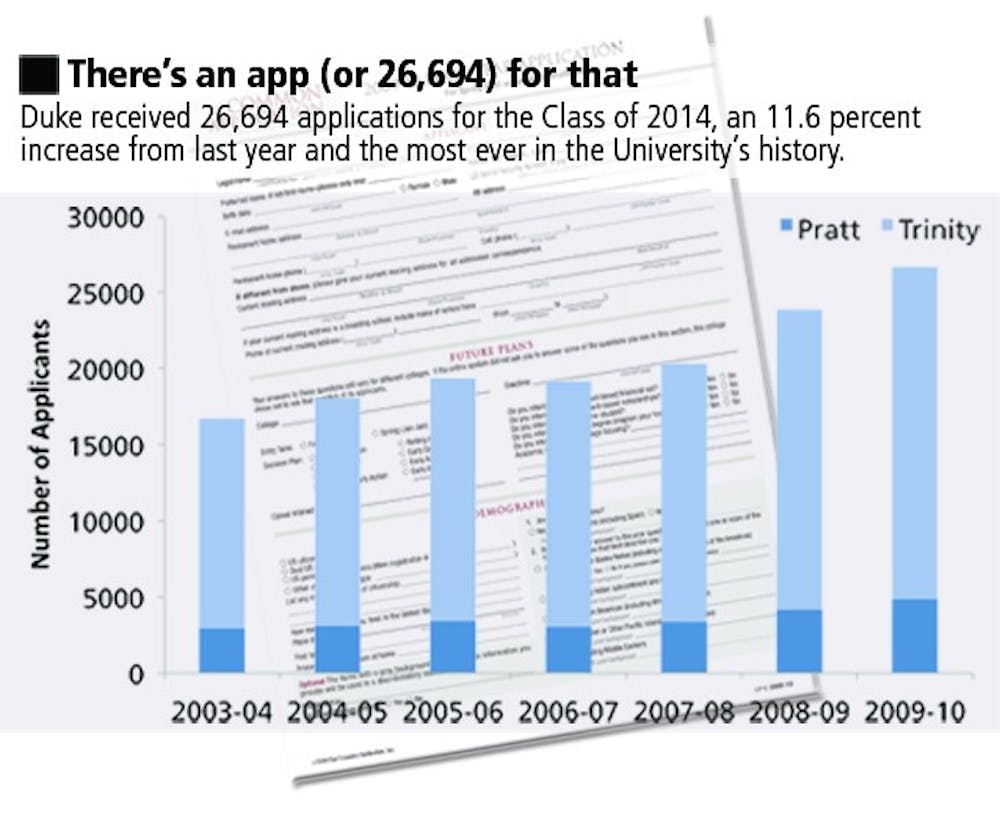As students start second semester, 24,682 regular decision applicants are waiting to hear whether they will be able to join them at Duke in the Fall.
Duke received applications from 26,694 high school students this year, 2,795 more than last year—an 11 percent increase, according to figures provided by Dean of Undergraduate Admissions Christoph Guttentag.
The jump in the number of applicants is smaller than last year’s 17 percent increase, but the Office of Undergraduate Admissions still saw substantial growth in both the early and regular application pools. The University also received 2,012 early applicants—about a 33 percent increase from last year.
“I can only have one theory—it reflects the perception that this is a great place to get an education,” President Richard Brodhead said.
Administrators cite heightened interest in Duke’s unique programs like DukeEngage, better recruiting in some states and the University’s effort to be affordable as possible reasons for the increase.
“I think part of it is related to the idea that when the economy is not so great... a number of families are going to consider an education at a place like Duke an investment in their child’s future and something that will pay off, not just economically, but in lots of ways,” Guttentag said. “It will pay off for their children down the line.”
The total number of applicants also reflects a larger international pool drawn by Duke’s growing visibility abroad, Guttentag said. There were 3,570 international applicants this year, 25.3 percent more than last year. This marks the largest swell in international applicants since the Class of 2009.
Because there are so many more applicants than in past years, admittances will be more selective, Guttentag added. There are only 1,100 spots left in the class after a record-breaking 602 early-decision applicants were admitted in December—50 more than last year.
“We just have to make very difficult decisions among many, many qualified and compelling candidates,” said Michael Schoenfeld, vice president for public affairs and government relations.
Whether this increase in applicants is a nationwide trend or something Duke-specific is still unclear.
“When we saw what had happened at other schools, we knew that our [early decision] numbers were specifically higher,” Provost Peter Lange said. “We’ll have to see if that’s true for regular decision as well.”
Brown University and the University of Chicago also experienced a dramatic increase in early applicants, while other universities saw smaller changes.
Of Duke’s applicants, 18.2 percent applied to the Pratt School of Engineering—approximately a 16.7 percent increase in applicants to Pratt from last year, and the largest proportion of Pratt applicants in the past seven years.
Although an increased number of applications is good news for Duke, deferred early applicants may feel otherwise.
In a pool of 2,012 early decision applicants, the 602 admits represent a 30 percent acceptance rate, which is 4 percent lower than last year. Of the remaining 1,410 applicants, 713 were deferred and 609 were denied admission. It is unclear whether the deferred early applicants will be affected by the large number of regular decision applicants, Guttentag said.
Typically, about 10 percent of deferred applicants are admitted regular decision.
“We always admit some students that we’ve deferred, and we like doing that,” Guttentag said. “I think that it’s not so much the size of the applicant pool as it is the quality of the regular decision applicant pool that may affect the students who were deferred.”
Overall, Duke saw slightly more female applicants than male, a trend that has been consistent for a few years. The states most represented were California, North Carolina, New York and Florida, and the top 11 most represented states have remained consistent for several years, Guttentag said.
Get The Chronicle straight to your inbox
Signup for our weekly newsletter. Cancel at any time.

